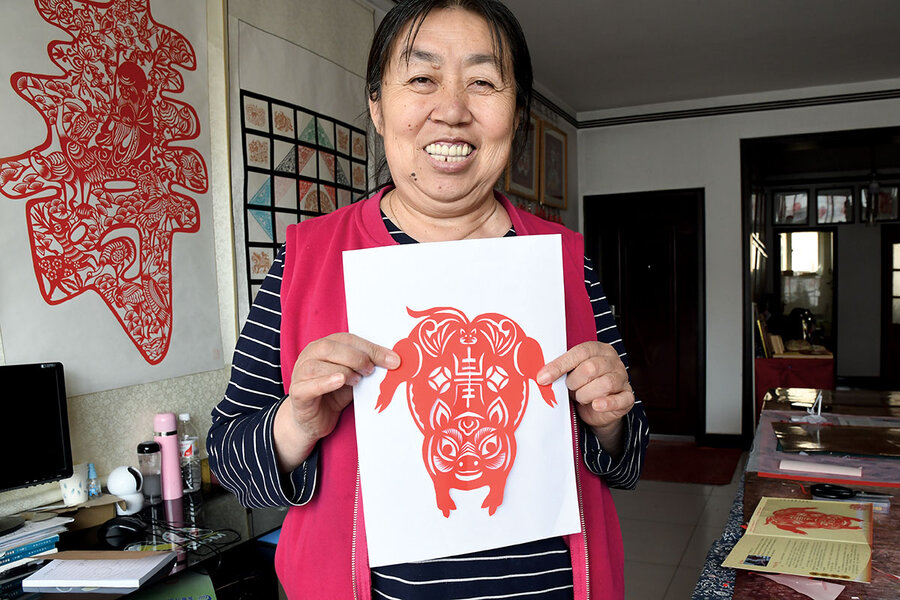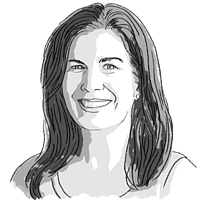This Chinese folk artist shares joy on paper, one snip at a time
Loading...
| Yan’an, China
An award-winning master of the ancient Chinese folk art of paper cutting, Yu Zeling fills her studio with cutouts of animals, people, and scenes so vivid that they seem to leap from the walls. Her art embodies village life in Ansai, a rural district on China’s rugged Loess Plateau.
Ansai is a center of paper cutting – recognized in 2009 by UNESCO as an Intangible Cultural Heritage of Humanity.
Why We Wrote This
A story focused onWomen are keeping the art of paper cutting alive in northwestern China. To ensure the craft’s future, they must pass on their passion to the next generation.
Once practiced by almost every village woman, paper cutting has waned in recent decades as millions of young people leave China’s countryside for cities and towns. But locals are working to keep the folk art alive.
Ms. Yu volunteers to teach at free community training sessions, serving as a bridge between the most skilled paper-cut artists of the 1980s – a golden era in paper cutting – and a new generation of heirs. Still, she is aware of the need to go beyond perpetuating traditions and embrace new paper-cut experiments.
“Can they engage contemporary artists in a way that their artwork remains relevant to their lives?” says Wu Ka-ming, an associate professor of cultural and religious studies at the Chinese University of Hong Kong. “That is a major question.”
With uncanny precision and attention to form, Yu Zeling snips away at the thin red paper. Her scissors seem to glide magically into place. After several minutes, she unfolds her creation: a bold and smiling Chinese zodiac pig.
An award-winning master of the ancient Chinese folk art of paper cutting, Ms. Yu fills her studio with cutouts of animals, people, and scenes so vivid that they seem to leap from the walls. Rich with symbolism, her art embodies village life in Ansai, a rural district in Shaanxi province on China’s rugged Loess Plateau. Ansai is a center of paper cutting – recognized in 2009 by UNESCO as an Intangible Cultural Heritage of Humanity.
Once practiced by almost every village woman, paper cutting has waned as China’s countryside has undergone vast changes in recent decades, with millions of young people leaving for cities and towns. “It’s a vanishing tradition,” says Wu Ka-ming, an associate professor of cultural and religious studies at the Chinese University of Hong Kong.
Why We Wrote This
A story focused onWomen are keeping the art of paper cutting alive in northwestern China. To ensure the craft’s future, they must pass on their passion to the next generation.
Yet Ms. Yu and others are working to keep the folk art alive, even as it evolves away from its roots as adornment for farmhouses and local celebrations. Indeed, the Ansai native is serving as a rare bridge between the most skilled paper-cut artists of the 1980s – a golden era in paper cutting – and a new generation of heirs.
“I love paper cutting,” says Ms. Yu with a smile as she carefully slips the eye-catching pig into a plastic sheet for display. “I just keep doing it!”
From Tang dynasty to Cultural Revolution
Growing up in a hamlet deep in an Ansai valley, surrounded by terraced fields, Ms. Yu came to paper cutting in the late 1970s as naturally as she breathed the earthy air.
“We were very poor, and when it was time to celebrate the [Lunar] New Year, we all put paper-cuts in the windows,” she says, recalling the holiday at her childhood home – a cave dug from a hillside – where her family of 10 eked out a living growing corn, beans, and sorghum. “Everyone did paper cutting,” she says, referring to village women.
The art originated in China in the centuries after paper was invented in A.D. 105 and proliferated during the Tang dynasty (A.D. 618-907). People first used the paper-cuts in sacrificial offerings and later fashioned them as decorations pasted on windows, doors, and walls during local festivals, weddings, and other celebrations. Paper cutting was practiced mainly by women, who were sometimes judged by the quality of their works.
Full of auspicious symbols from peasant life, the decorations heralded good weather, many offspring, long life, wealth, and happiness. Regions created distinct styles, with Shaanxi known for more crude, primitive designs.
In the 20th century, political movements appropriated the vibrant paper-cuts, especially in Shaanxi. Mao Zedong and his Communist Party-led Red Army created a base in northern Shaanxi in the 1930s and used paper-cuts to mobilize support. After the 1949 revolution, propagandists mass-produced the folk art to depict people living happily under Communist rule.
Party campaigns that intended to make art serve political goals increasingly suppressed the traditional content of paper cutting, which embodied religious beliefs, superstition, and romance. During Mr. Mao’s radical decadelong Cultural Revolution – launched in 1966, the year Ms. Yu was born – some Ansai peasant women artists were publicly criticized for making paper-cuts with traditional themes.
But all this changed in the post-Mao years. Just as Ms. Yu was beginning to learn paper cutting, after she left elementary school in 1978 at the age of 12, China’s shift toward market economics and social opening began allowing for a revival of traditional culture.
Joining the masters
Using discarded newspaper, Ms. Yu first practiced cutting the image of a Chinese national flag that she saw in a school textbook. She says she “cut it 100 times” before she was satisfied. Then her aunt took over, introducing her to increasingly complicated traditional motifs.
“My aunt taught me very well,” she says. Farming by day, by night she would join female relatives to make paper-cuts, sometimes using them as patterns to embroider shoes and pillows.
Meanwhile, a research scholar named Chen Shanqiao began trekking from Ansai’s county seat into the hills and valleys to rural villages, rediscovering the true meanings embedded in the paper-cuts. Their power astonished him. In the mid-1980s, he recruited a few older village women who were masters in the craft to come teach at Ansai’s Cultural Center.
Ms. Yu married farmer Jiang Zhicheng, who admired her passion and skill. Inspired, Mr. Jiang took a few of his wife’s works to the local market in 1987, but he couldn’t sell them. So he went farther, riding his bicycle more than 25 miles to Ansai’s Cultural Center. Seeing the fine pieces, Mr. Chen immediately bought the paper-cuts and invited Ms. Yu to come train with the master artists, including Bai Fenglian, whose work was later recognized by UNESCO.
At last, Ms. Yu could devote herself fully to the art. “With her talent, she learned quickly and progressed a lot, and gradually caught up” with the master teachers, says Mr. Jiang.
After years of training, Ms. Yu became a master in her own right, winning one award after another. Her works are on display in museums. But she’s humble about her achievements. “I was, and still am, a farmer,” she says with a smile.
Reflections of rural life
Moving around her studio, she prefers to talk about the rural life and customs that she grew up with and that inspire her art. One paper-cut depicts a line from a northern Shaanxi folk song about parting lovers. Another shows a wedding tradition in which the groom combs the bride’s hair.
“I make paper-cuts based on life,” she says. “Here in northern Shaanxi, we feed the pigs and till the land and care for the children.”
Hoping to carry on and grow the folk art, Ms. Yu volunteers to teach at free community training sessions. Paper cutting is also taught in Ansai’s public schools. “Some young people only want to sell the paper-cuts and quit if they can’t,” she says. But others enjoy the craft and keep it up, often seeking her advice, she adds.
Still, as Chinese villages empty out and rural rituals fade, Ms. Yu is aware of the need to go beyond perpetuating traditions and embrace new paper-cut experiments.
“Can there be innovation in terms of motifs, or does this intangible cultural heritage always have to be the reinvention of tradition?” says Dr. Wu, the professor. “Can they engage contemporary artists in a way that their artwork remains relevant to their lives? That is a major question.”
For her part, Ms. Yu tries to address this tension, and span the generations, by simply setting an example – demonstrating the ongoing,
intimate connection between her life and work.
The most elaborate paper-cut in her studio is a large and ornate circular design that weaves together layer upon layer of significance: In the center, a snake (man) encircles a rabbit (woman), symbolizing marriage. Surrounding them is a ring of pomegranates (the seeds of which represent many children), peaches (the Chinese name for “peach” is also the word for “longevity”), and Buddha’s hands (a kind of citrus fruit representing bliss). A final outer rim, resembling a woven flower basket, also signifies longevity.
“My works,” she says, “have a lot of meaning.”










